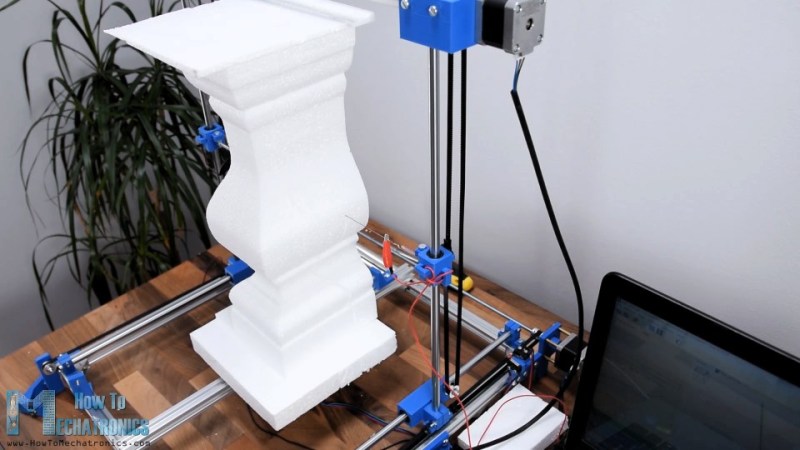Rapid prototyping tools are sometimes the difference between a project getting off the ground and one that stays strictly on paper. A lightweight, easy-to-form material is often all that’s needed to visualize a design and make a quick judgment on how to proceed. Polymeric foams excel in such applications, and a CNC hot-wire foam cutter is a tool that makes dealing with them quick and easy.
We’re used to seeing CNC machines where a lot of time and expense are put into making the frame as strong and rigid as possible. But [HowToMechatronics] knew that the polystyrene foam blocks he’d be using would easily yield to a hot nichrome wire, minimizing the cutting forces and the need for a stout frame. But the aluminum extrusions, 3D-printed connectors. and linear bearings he used still make for a frame stiff enough to give clean, accurate cuts. The addition of a turntable to the bed is a nice touch, turning the tool into a 2.5D machine. The video below details the construction and goes into depth on the toolchain [HowToMechatronics] used to go from design to G-code, including the tricks he used for making a continuous path, as well as integrating the turntable to make three-dimensional designs.
Plenty of hot-wire foam cutters have graced our pages before, everything from tiny hand-held cutters to a hot-wire “table saw” for foam. We like the effort put into this one, though, and the possibilities it opens up.
Thanks to [Keith O.] for the tip.
















It’s not much more complicated to cut the inverse model and use it to cast shapes in concrete.
Entirely dependent on the application, trying to cut an inverse of something like the round chess piece in the beginning isn’t possible, but if you want to make a mold of some big blocky letters then that’s easy.
How would you cut concave sections?
How does that happen with a straight hot wire? Or are you gonna give it a soldering iron and have it iteratively stab the mould into shape?
I was thinking the same thing. “It’s not too much more complicated…” WHA?
I mean, after a complete redesign, discarding all current principles of operation, you could use it as a Mars rover too. :-D
Thought about making one of these many, many years ago. It’s great that others complete my back of the back-burner projects and allow me to vicariously enjoy the result :O)
I saw this when it came out and the one thing i was curious about is with so many of the 32 bit boards dropping in price (skr 1.3) how much more difficult would it be to use one of those?
Barton Dring has a port of grbl to the esp32. https://github.com/bdring/Grbl_Esp32
So not that difficult :)
Do like how versatile it is.
Great detail in demonstrating how made along with software and examples. Got me thinking some CNC designs can be modified to make use of for and was wondering about modifications for asymetrical cuts or using the wire knife too… though the wire knife might be better on a robot arm or better an arm on the boom/gantry.
I have one on the building board still. I got to the point of testing out the motors, and became discouraged at the thought of using an obsolete parallel printer board. How does the adrino interface?